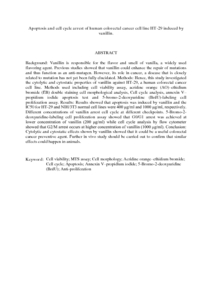Citation
Ho, Ket Li and Saiful Yazan, Latifah and Ismail, Norsharina and Ismail, Maznah
(2009)
Apoptosis and cell cycle arrest of human colorectal cancer cell line HT-29 induced by vanillin.
Cancer Epidemiology, 33 (2).
pp. 155-160.
ISSN 1877-7821; ESSN: 1877-783X
Abstract
Background:
Vanillin is responsible for the flavor and smell of vanilla, a widely used flavoring agent. Previous studies showed that vanillin could enhance the repair of mutations and thus function as an anti-mutagen. However, its role in cancer, a disease that is closely related to mutation has not yet been fully elucidated.
Methods:
Hence, this study investigated the cytolytic and cytostatic properties of vanillin against HT-29, a human colorectal cancer cell line. Methods used including cell viability assay, acridine orange (AO)–ethidium bromide (EB) double staining cell morphological analysis, Cell cycle analysis, annexin V–propidium iodide apoptosis test and 5-bromo-2-deoxyuridine (BrdU)-labeling cell proliferation assay.
Results:
Results showed that apoptosis was induced by vanillin and the IC50 for HT-29 and NIH/3T3 normal cell lines were 400 μg/ml and 1000 μg/ml, respectively. Different concentrations of vanillin arrest cell cycle at different checkpoints. 5-Bromo-2-deoxyuridine-labeling cell proliferation assay showed that G0/G1 arrest was achieved at lower concentration of vanillin (200 μg/ml) while cell cycle analysis by flow cytometer showed that G2/M arrest occurs at higher concentration of vanillin (1000 μg/ml).
Conclusion:
Cytolytic and cytostatic effects shown by vanillin showed that it could be a useful colorectal cancer preventive agent. Further in vivo study should be carried out to confirm that similar effects could happen in animals.
Download File
![[img]](http://psasir.upm.edu.my/13214/1.hassmallThumbnailVersion/Apoptosis%20and%20cell%20cycle%20arrest%20of%20human%20colorectal%20cancer%20cell%20line%20HT.pdf)  Preview |
|
PDF (Abstract)
Apoptosis and cell cycle arrest of human colorectal cancer cell line HT.pdf
Download (186kB)
| Preview
|
|
Additional Metadata
Actions (login required)
 |
View Item |

